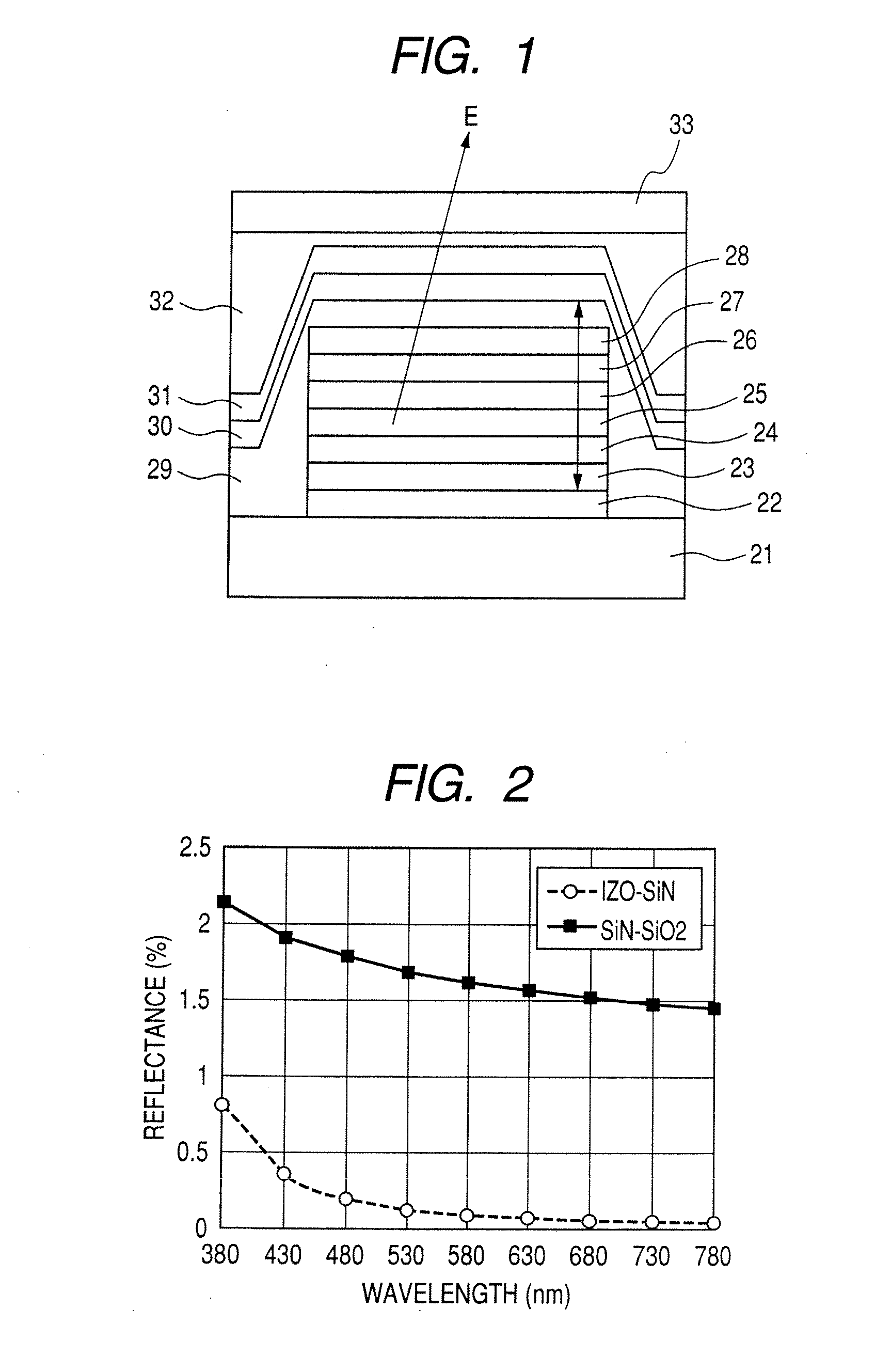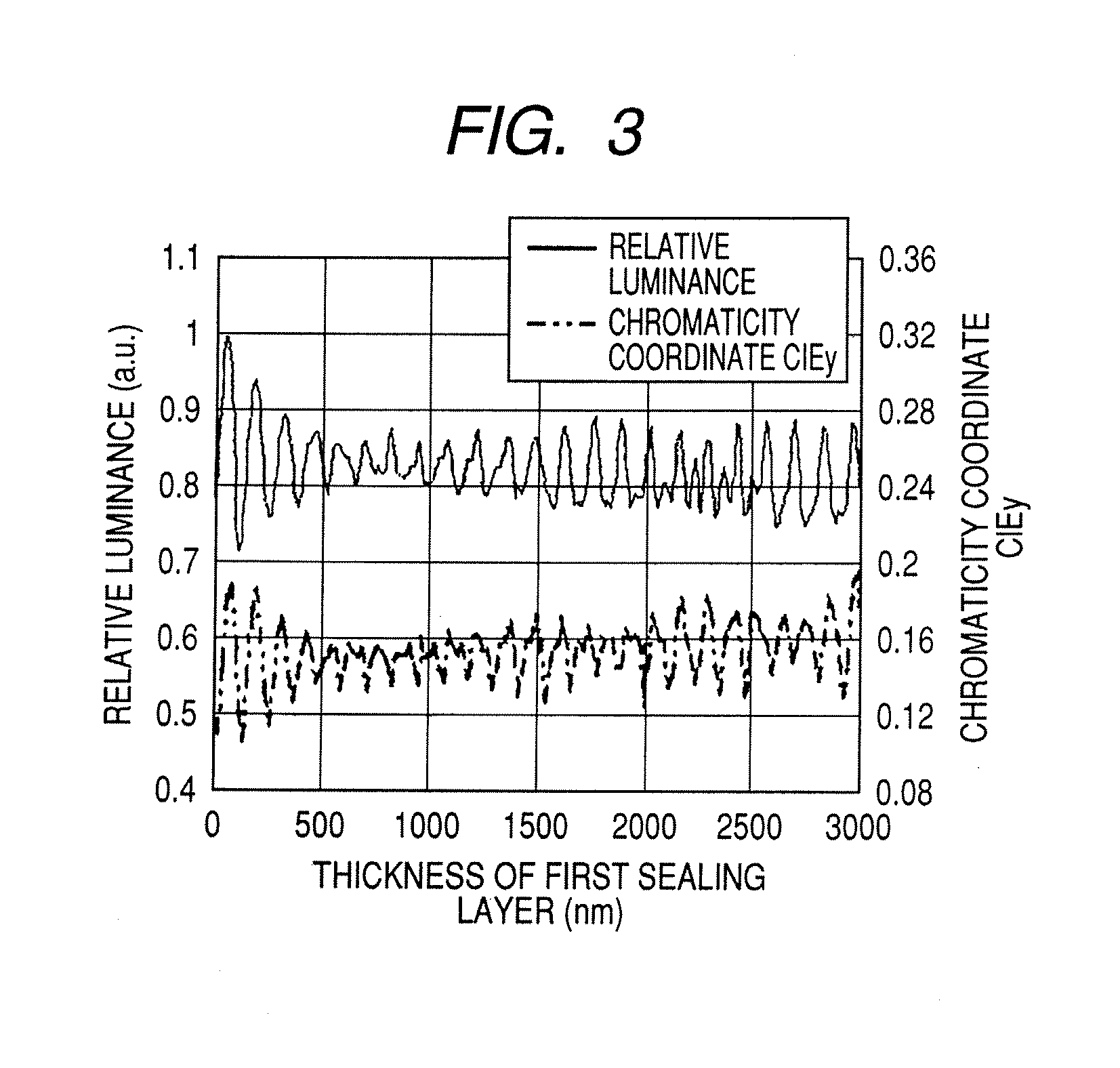Organic light-emitting device and display apparatus using the same
a light-emitting device and display device technology, applied in the direction of discharge tube/lamp details, organic semiconductor devices, discharge tubes, etc., can solve the problems of oxidation of electrodes, deterioration of organic compounds, peeling of electrodes/organic substances, etc., to reduce the resonance effect of microcavity structures, and reduce the effect of film thickness variation
- Summary
- Abstract
- Description
- Claims
- Application Information
AI Technical Summary
Benefits of technology
Problems solved by technology
Method used
Image
Examples
example 1
[0098]The organic light-emitting device having the structure illustrated in FIG. 1 was produced by the method described below. On a glass substrate 21, silver alloy (AgCuNd) having a film thickness of approximately 100 nm serving as the reflective electrode 22 and IZO having a film thickness of 10 nm serving as the transparent conductive layer 23 were formed by sputtering. This substrate was ultrasonically cleaned with isopropyl alcohol (IPA), washed with boiled water, and then dried. Further, after being cleaned with UV / ozone, organic compound layers were formed by a vacuum evaporation method.
[0099]First, as the hole-transporting layer 24, a film of Compound (I) represented by the following structure formula was formed in a thickness of 10 nm. At that time, the degree of vacuum was 1×10−4 Pa, while the evaporation rate was 0.2 nm / sec.
[0100]Then, as the emission layer 25 that emits blue light, a film was formed in a thickness of 20 nm by coevaporation of Compound (II) shown below as...
example 2
[0111]In the present example, an organic light-emitting device was produced by following the same procedure as in Example 1 with the exception that the film thickness of the first sealing layer was 1,000 nm.
[0112]As shown in Table 12, according to this organic light-emitting device, an organic light-emitting device that has stable emission characteristics and exhibits excellent light emission even when a film thickness fluctuation occurs can be produced in a simple process with a satisfactory throughput.
example 3
[0117]A display apparatus of three colors of RGB having the structure shown in FIG. 8 was produced by the method described below.
[0118]On a glass substrate 101 serving as a support member, a TFT drive circuit 102 including a low temperature polysilicon was formed, and a planarizing film 103 of an acrylic resin was formed thereon, whereby a substrate was obtained. Then, on the substrate, a film of a silver alloy (AgCuNd) as a reflective metal 104 was formed in a thickness of approximately 100 nm by a sputtering method and patterned. The reflective metal 104 was electrically connected to the TFT drive circuit 102 through contact holes 105. After that, a film of IZO as a transparent conductive layer 106 was formed in a thickness of 10 nm by a sputtering method and patterned. Further, a device separation film 107 was formed using an acrylic resin. This substrate was ultrasonically cleaned with isopropyl alcohol (IPA), washed with boiled water, and then dried. Further, after being cleane...
PUM
 Login to View More
Login to View More Abstract
Description
Claims
Application Information
 Login to View More
Login to View More - R&D
- Intellectual Property
- Life Sciences
- Materials
- Tech Scout
- Unparalleled Data Quality
- Higher Quality Content
- 60% Fewer Hallucinations
Browse by: Latest US Patents, China's latest patents, Technical Efficacy Thesaurus, Application Domain, Technology Topic, Popular Technical Reports.
© 2025 PatSnap. All rights reserved.Legal|Privacy policy|Modern Slavery Act Transparency Statement|Sitemap|About US| Contact US: help@patsnap.com



